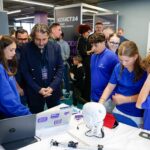Poland, like much of Central and Eastern Europe (CEE), stands at a crossroads in its infrastructure development.
The country’s infrastructure needs—spanning energy, transportation, digital networks, and urban development—are vast and urgent. Traditionally, these have been addressed through a combination of government funding and European Union (EU) support.
However, as the markets within CEE grow richer, reliance on EU funding is decreasing, leaving an increasingly visible gap in infrastructure financing—around 500 billion euros.
Recently I took part in a panel discussion at the Karpacz Economic Forum, where together with officials from the Polish Development Bank (BGK) and European Investment Bank (EIB), we explored ‘Possibilities of Financing Strategic Investments’ across CEE.
My argument, based on my experiences raising capital and investing in infrastructure both in the region and internationally, is that local pension funds and insurance companies could provide the answer to bridging this gap.
Pension funds, insurers and infrastructure: A perfect match
Pension funds, which are tasked with providing stable, long-term returns to secure citizens’ retirements. Similarly, insurance companies, especially life insurers, are characterised by long-term liabilities that extend over decades.
Infrastructure projects, such as roads, energy grids, and airports, typically provide stable, inflation-hedged returns over long periods—exactly what pension funds and insurers need to meet their future liabilities. In mature Western markets, these institutional investors have been key players in building and modernising infrastructure, yielding both strong financial returns and broad social benefits.
In Canada, where I was raised before coming to the region, the 1990s presented a situation much like Poland’s today—significant infrastructure investment was needed, but federal budget constraints made it difficult to finance projects.
The solution? Pension funds and insurers stepped in and today, Canadian’s pension funds are some of the world’s largest infrastructure investors. The Baltic Hub, located in Poland’s own Gdańsk port, is in itself a use-case success story: international pension funds own a 30 per cent stake in this key piece of infrastructure, demonstrating the feasibility of pension fund involvement in Poland.
The pension fund landscape
Unfortunately, pension funds and insurance companies across the CEE region have largely shied away from large-scale infrastructure investments. Currently, over 60 per cent of Polish pension fund assets are invested in government bonds and treasury bills. While these investments provide security, they yield low returns and do little to contribute to the nation’s broader economic development.
There are several reasons for this conservative approach. Polish pension funds are restricted by regulations that limit their ability to invest outside of traditional asset classes (such as government bonds, listed equities); only 15 per cent of pension fund resources can be allocated to investment funds which can provide further diversification.
In addition to regulatory constraints, pension funds often lack the expertise needed to invest into infrastructure projects, whilst the West has built up an ecosystem of fund managers designed to assess and manage investments in infrastructure on behalf of pension funds.
Despite these challenges, the potential for institutional investors to play a transformative role in CEE infrastructure development is clear. Several initiatives in the region demonstrate the benefits of this approach.
The Three Seas Initiative Investment Fund (3SIIF), for example, which our team at Amber Infrastructure has advised for the past four years, has mobilised nearly one billion US dollars billion in investments from regional development banks with a focus on energy, transport, and digital infrastructure. This successful and commercially-driven fund highlights the growing opportunity for pension funds to enter the infrastructure space.
Moreover, the need for private capital in Poland is rising. National funds, while important, are increasingly constrained by budget limitations, and EU funds will not last forever. Despite Poland being set to receive significant EU financial support over the coming years, including 72 billion euros from the Cohesion Fund, much of this is earmarked for climate-related goals and digital transformation projects, as opposed to infrastructure which also requires much-needed investments. As the country continues to grow, space for private and institutional capital in other infrastructure sectors will only increase.
Local pension funds should step in
There are compelling reasons for Polish pension funds to reconsider their investment strategies. First, the Polish pension system—like many others in the CEE region—lags behind its Western European counterparts in terms of both adequacy and sustainability. Only 28 per cent of Poles feel confident they will have enough money to live comfortably in retirement, a stark contrast to higher confidence levels in countries like Denmark (58 per cent) or the Netherlands (59 per cent)—the latter having among the most developed pension systems in the world.
Second, though Poland’s infrastructure leads the CEE by example, its needs are growing and are too great to neglect. In the railway sector alone, over 230 infrastructure projects worth around 17 billion euros are planned, primarily linking new cargo routes from the south of the country to the seaport in the north and those in large cities.
Road transportation is also in need of financial support, with around 38 billion euros worth of new projects planned this decade. The airport and maritime sectors tell a similar story as Poland’s economy grows in size and stature; from modernising transportation networks to expanding energy systems and digital connectivity, the country faces a critical juncture. By stepping into this space, pension funds can both secure higher, long-term returns and contribute to the country’s stability and prosperity.
To make this vision a reality, regulatory reforms are needed. Pension funds and insurers must be given more flexibility to invest in infrastructure projects. Furthermore, institutional investors need access to better expertise and stronger cooperation with specialist fund managers that have a proven track record in infrastructure investment.







